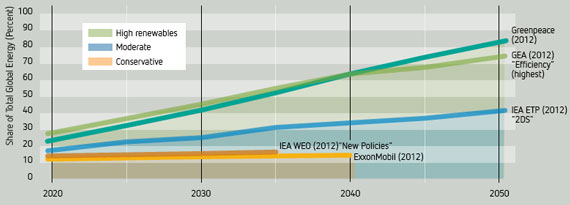| Feb 19, 2013 |
The long-term future of renewable energies
|
|
(Nanowerk News) The REN21 Renewables Global Futures Report (pdf) is a pioneering publication that provides access to the range of credible possibilities on the future of renewable energy. The report is based on interviews with over 170 leading experts around the world and the projections of 50 recently published scenarios. The report can serve as a tool for dialogue and discussion on future options, and compliments well the REN21 Renewables Global Status Report.
|
|
Released in January 2013, the report was authored by Dr. Eric Martinot and was the product of a unique collaboration between REN21 and the Institute for Sustainable Energy Policies (ISEP) during 2011-2012.
|
|
The evolution of policies and markets for renewable energy has
been absolutely remarkable over the past decade. The annual
REN21 Renewables Global Status Report provides evidence of this
rapid development. In 2011, over $260 billion was invested in new
renewable energy capacity, more than for fossil fuel and nuclear
power combined. This is up from just $40 billion in 2004. In 2011,
some 120 countries around the world had policies to support renewable
energy; most are now developing countries. In 2004, countries
with support policies numbered about 50, then mostly developed
countries. In 2011, the annual solar photovoltaic (PV) market was
30-fold greater than in 2004. And in many other respects, policies
combined with technology cost reductions have driven markets in
unprecedented ways.
|
|
With the trends of the past 10 years behind us, and with the dynamic
nature of renewable energy markets, technologies, and cost reductions
continuing, we can look to the future with a very different
perspective than in 2004.
|
|
The purpose of this report is to show the range of credible possibilities
for the future of renewable energy. It does not present just one
vision of the future, but rather a full and objective range of visions,
based on the collective and contemporary thinking of many.
|
|
This report combines a unique array of interviews with 170 experts
from around the world, along with over 50 recently published
scenarios. These interviews and scenarios are blended into a
“mosaic” of thinking about the future. Persons interviewed included
industry and finance experts, CEOs and business managers,
researchers and academics, policymakers and parliamentarians,
and public advocates and visionaries, among many others. Views of
existing energy companies are also included.
|
 |
| Conservative, moderate, and high-renewables scenarios to 2050
|
|
Many existing energy companies, especially those with a vested
interest in the status quo, project conservative future shares of
renewable energy and emphasize cost hurdles and variability challenges.
These companies continue to believe that the future will be
dominated by fossil fuels. Such “conservative” outlooks project the
share of renewable energy in global energy supply remaining below
20% in the future, not much higher than today.
|
|
“Moderate” outlooks by experts and scenarios project renewable
energy shares of 30–45% by 2050, including electricity, heating/
cooling, and transport. In such outlooks, renewable electricity is
integrated into power grids at high shares (i.e., 50–80%) using a
variety of options such as demand-response, balancing with natural
gas, new market structures for balancing services, and some energy
storage. Transport employs modest but growing amounts of biofuels,
along with electric vehicles and plug-in hybrids, partly charged
from renewable electricity, and some modal shifts of freight to
more-electric options.
|
|
“High renewables” outlooks project 50–95% energy shares by
2050. Such shares were cited by many experts, and are projected
in several scenarios, typically those of public advocacy organizations,
but also in recent scenarios of the International Energy
Agency (IEA), which has traditionally published more conservative
projections. High-renewables projections typically show some
combination of significant and continued renewable energy cost
reductions, along with aggressive and long-term support policies
for renewable energy, and major transformations in energy markets
and infrastructure.
|

